“The great thing about music is that it’s a universal language.” – John Denver.
In 2025, music streaming apps are not just a trend- they’re a way of life.
People from all corners of the world rely on music apps to listen to their favorite artists or songs, no matter their location or taste.
With millions of people tuning in every day, the demand for seamless, personalized music experiences has skyrocketed.
If you’re considering building your own music streaming platform, you’re probably wondering: How much does it cost to create a music app?
A ballpark figure for music streaming app development costs goes from $20,000 to $ 150,000+.
The answer depends on various factors, but one thing’s for sure: investing in the right features and user experience can lead to massive growth.
This blog will give you the necessary information about the cost of music app development to create a successful music app in 2025,
Let’s get started.
Why Invest in Music Streaming Apps In 2025?
Music streaming is more than just a fun hobby for millions of people- it’s an essential part of their daily routine. So, why should you invest in building a music streaming app?
The growth in this industry shows no signs of slowing down, and there are several solid reasons why it’s worth considering.
1. Music Market is Booming
With over 600 million paid subscribers expected worldwide by 2025, music streaming is a rapidly expanding market.
The demand for personalized and on-the-go music consumption is only growing, making it an ideal time to jump in.
2. Opportunity to Earn Money
The global revenue from music streaming is projected to exceed $30 billion by 2025.
With various monetization options, from premium subscriptions to ads, there’s plenty of room for profitability. This is an industry that rewards innovation.
3. Changing Consumer Habits
Gone are the days of physical music collections. Today, consumers expect instant access to their favorite tracks anytime, anywhere.
As streaming platforms replace traditional music consumption methods, turning an app idea into reality is a great way to align with this shift in behavior.
Average Music App Development Cost
So, how much does it cost to create a music app? This is one of the frequently asked questions for people looking to create their own music app.
Well, the estimated cost to make a music app can go from $20,000 to $150,000+.
This cost can vary greatly depending on the complexity, design, and features you want.
A basic app with simple streaming functionality could cost around $20,000, but if you want advanced features like offline listening, personalized playlists, or high-end UI/UX design, the cost could easily climb to $150,000 or more.
Remember, the cost of music app development also includes ongoing expenses, such as licensing and maintenance, which can add significant amounts to the total.
|
App Type |
Key Features |
Cost Range |
|
Basic App |
Core features like playlists, music catalogs, and basic playback. |
$20,000 - $40,000 |
|
Intermediate App |
Offline playback, personalized recommendations, and multi-device support. |
$40,000 - $80,000 |
|
High-End App |
Live streaming, AI-powered suggestions, advanced analytics. |
$80,000 - $150,000+ |
Let’s see a breakdown of this music app's cost to avoid any confusion:
1. Basic Music App
Cost range: $20,000-$40,000
A basic music app focuses on simple, straightforward music streaming functionality.
-
- Key Features: It includes features like user registration, music search, and basic playlists.
- Design: The design is functional but minimal, and the app supports the essential music streaming experience.
- Ideal for: People looking to develop a music app for a startup with a desire to enter the market with a cost-effective solution.
2. Mid-Tier Music App
Cost Range: $40,000 - $80,000
Mid-tier music apps are those apps that have more than basic functions with some extra elements.
-
- Key Features: A mid-tier music app offers more advanced features, such as personalized playlists, music recommendations, social sharing options, and offline listening.
- Design: The user interface (UI) and user experience (UX) design are more polished compared to a basic app, creating a better, more seamless experience for users.
- Ideal for: This level of the app is great for businesses aiming to offer a more engaging and feature-rich music streaming experience while still maintaining a reasonable development budget.
3. High-End Music App
Cost Range: $80,000 - $150,000+
A high-end music app offers a premium, fully customized experience.
-
- Key Features: It includes all the functions of a mid-tier music app but with enhanced functionality like high-definition audio streaming, using AI in music apps, extensive music catalogs, and possibly integration with smart devices.
- Design: High-end UI/UX design is a key feature, and the app is built to handle high traffic and provide a flawless, enjoyable experience across all platforms.
- Ideal for: This version is ideal for large companies or entrepreneurs who want to invest in a top-tier product that stands out in the competitive music streaming market.
We believe you got an understanding of the cost and now understand that every project is different, so is the cost.
In the next section, we will understand how to calculate the cost to throw the guesswork out.
How to Calculate Your Music App Development Cost?
If you're asking how much does it costs to create a music app, the answer isn't one-size-fits-all.
The total cost varies based on several factors, from the type of features you want to implement to the complexity of the design and development.
Here's a simple way to calculate your music app development cost:
► Formula to Calculate Music App Development Cost
Total Cost = (App Type Cost) + (Design Complexity Cost) + (Backend Development Cost) + (Licensing & Royalties Cost)
Where:
-
- App Type Cost: This depends on whether you're building a basic, mid-tier, or high-end app.
- Design Complexity Cost: Includes the cost of UI/UX design based on the complexity (simple to high-end).
- Backend Development Cost: This refers to the server-side infrastructure and features you need for scalability and performance.
- Licensing & Royalties Cost: This includes the cost of music licensing, which varies depending on the size of the music catalog and other factors.
This will help you greatly, but remember you should consult with the best mobile app development company to get the clear cost for your project.
Factors Affecting the Overall Music App Development Cost
If you are asking yourself How much does it cost to create a music app?
It’s important to understand that several factors can impact the final price.
The cost to build a music app is not set in and depends on various aspects of the app's functionality and design.
1] App Type and Features
Want to know the cost to develop a music app? It all starts with the features you want to include.
A basic app with simple streaming will cost less, but if you add advanced features like offline listening, personalized recommendations, and social sharing, the price can rise dramatically.
The more functionality you add, the higher the cost to create a music app will be. So, carefully plan your feature set to align with your budget.
|
Feature Type |
Price Range |
|
Basic Features (Playlists, Search, Playback) |
$10,000 - $25,000 |
|
Advanced Features (AI, Offline Mode) |
$25,000 - $40,000 |
|
Premium Features (Live Streaming, Podcasts) |
$40,000 - $50,000 |
2] Design Complexity
UI/UX design significantly impacts the cost to make a music app. App wireframe and prototype play an important role.
A simple, minimal design will keep costs low, while a custom, high-end design with intricate animations, transitions, and advanced interactions will increase the development budget.
The complexity of the design plays a big role in the cost to build a music app, as it requires specialized resources and expertise to create an engaging and visually appealing user experience.
|
Design Complexity |
Estimated Cost |
|
Simple/Minimalistic Design |
$5,000 - $10,000 |
|
Custom Design with Animations |
$15,000 - $30,000 |
|
High-End Design (Premium UX/UI) |
$30,000 - $50,000 |
3] Backend Development
Think of the backend as the engine driving your music app.
The cost to develop a music app will increase with the complexity of the backend.
More sophisticated backend structures are required for handling large user bases, supporting high-quality streaming, and maintaining seamless data synchronization.
This is one area where skimping on quality can seriously affect the app’s performance.
|
Backend Complexity |
Estimated Cost |
|
Basic Backend (Limited Features) |
$10,000 - $20,000 |
|
Medium Backend (Scalability) |
$20,000 - $40,000 |
|
Advanced Backend (High Traffic) |
$50,000 - $60,000 |
4] Development Team Location
The location of your development team plays a huge role in your app’s overall development cost.
If you hire app developers in countries with higher living costs (like the U.S. or Western Europe), expect a premium.
However, outsourcing to developers in regions like Eastern Europe or India can significantly lower costs without compromising quality.
Choose the right location based on your budget and the quality of talent you need.
|
Team Location |
Estimated Cost |
|
Western Europe / U.S. |
$50 - $150/hour |
|
Eastern Europe |
$30 - $75/hour |
|
India / Southeast Asia |
$15 - $40/hour |
5] Platform Choice
Deciding whether to go for the native app ( iOS app development or Android app development) or both can drastically affect the cost to build a music app.
Developing for a single platform is more cost-effective, but if you want to reach a wider audience, you’ll need to build for both.
Cross-platform development may require more time and resources, but it ensures that users on both iOS and Android have access to your music app.
|
Platform |
Price Range |
|
iOS Only |
$20,000 - $50,000 |
|
Android Only |
$50,000 - $80,000 |
|
Both iOS & Android |
$80,000 - $150,000 |
6] App Security
App Security is an absolute must in today’s digital world!
If your app handles personal user data or payment information, you’ll need robust security features.
The cost to develop a music app will rise if you integrate high-end security systems, such as encryption, secure login, and payment gateways.
Ensuring top-notch security not only builds trust but protects your users from potential threats.
|
Security Features |
Estimated Cost |
|
Basic Security |
$5,000 - $15,000 |
|
Advanced Security (Encryption) |
$20,000 - $40,000 |
|
High-Level Security (Payment Gateways) |
$30,000 - $50,000 |
7] Integration with Third-Party Services
Want to connect your music app with social media, payment systems, or cloud storage?
These integrations can significantly increase the cost to make a music app.
Adding third-party services involves additional development work, testing, and API integrations, which all add to your budget.
Ensure that each integration aligns with your app’s goals and justifies the extra investment.
|
Third-Party Integration |
Estimated Cost |
|
Basic (Social Media Integration) |
$5,000 - $10,000 |
|
Medium (Payment Gateways) |
$10,000 - $30,000 |
|
Complex (Multiple Integrations) |
$30,000 - $50,000 |
8] Maintenance & Updates
After your app is live, app maintenance services become an ongoing expense.
It’s crucial to fix bugs, update features, and keep your app compatible with new operating system versions.
The cost to make a music app doesn’t stop at launch.
Plan for continuous maintenance and support, which will ensure your app remains functional, secure, and up to date with the latest trends and technologies.
|
Maintenance Type |
Annual Estimated Cost |
|
Basic Maintenance |
$5,000 - $10,000 |
|
Regular Updates & Bug Fixes |
$10,000 - $20,000 |
|
Premium Maintenance (24/7 Support) |
$20,000 - $50,000 |
9] Cost of Hiring a Development Team (In-House vs. Outsourcing)
The debate over whether to choose In-house development, Staff Augmentation, or Outsourcing is always a trending topic.
Each option has its pros and cons, and the question remains: which one is the best?
Whatever your decision is, it will impact the cost to create a music streaming app.
An in-house team tends to be more expensive due to salary, benefits, and office space, but it provides more control and communication.
Outsourcing, on the other hand, is cost-effective but may come with challenges such as time zone differences.
|
Development Team Location |
Estimated Cost |
|
In-House (US/Western Europe) |
$50 - $150/hour |
|
Outsourcing (Eastern Europe/Asia) |
$20 - $75/hour |
|
Freelancers |
$25 - $100/hour |
These are just some common factors that affect the cost of music streaming app development.
Time to know about some hidden factors too.
Hidden Factors of Music Streaming App Development Cost
Building a music streaming app is not just about coding and design. While the core development process is essential, many hidden costs could make or break your budget.
These costs, if overlooked, could drastically affect your overall music streaming app development cost.
So, before you dive into app creation, let’s explore some of the lesser-known but crucial factors that will shape your final cost.
A] Music Licensing and Royalties
If you’re planning to stream music from popular artists, you’ll quickly realize that music licensing and royalties are among the largest expenses.
These fees are ongoing and vary based on the catalog you want to include.
Whether you go for major label hits or indie tracks, you’ll need to negotiate with rights holders, and those licensing deals can significantly increase your cost to develop a music streaming app.
These fees are a hidden but crucial cost that often takes up a big chunk of your budget.
|
Music Licensing Type |
Estimated Cost |
|
Indie Artists & Smaller Catalogs |
$10,000 - $30,000 |
|
Major Labels (Popular Songs) |
$30,000 - $50,000+ |
|
Comprehensive Catalog (Full Licensing) |
$50,000 - $70,000+ |
B] App Store Fees
Getting your app into the App Store or Google Play is essential, but it’s not free.
App Store fees include hosting your app and the platform’s commission from in-app purchases, ads, and subscriptions.
Apple takes a 15-30% commission, which can eat into your earnings.
The cost to build a music streaming app can creep up thanks to these store fees, which you’ll need to factor into your overall budget for a successful launch.
|
App Platform |
Fees & Commissions |
|
Apple App Store |
15% - 30% commission |
|
Google Play Store |
15% - 30% commission |
|
Annual Developer Account Fees |
$99/year (Apple), $25 (Google) |
C] Marketing and User Acquisition
What good is an app if no one knows about it?
The cost to create a music streaming app includes more than just development-it also includes marketing and user acquisition.
To stand out in a crowded market, you’ll need to budget for paid ads, influencer partnerships, and app store optimization (ASO).
These marketing costs can quickly add up, but they’re crucial to ensuring your app reaches its audience and gets the downloads it deserves.
|
Marketing Channel |
Estimated Cost |
|
Paid Ads (Social Media, Google) |
$10,000 - $50,000 |
|
Influencer Partnerships |
$5,000 - $30,000 |
|
App Store Optimization (ASO) |
$5,000 - $15,000 |
D] Infrastructure Scaling Costs
As your user base grows, so will the infrastructure scaling costs.
Your servers, storage, and data management systems will need to expand to handle more traffic and high-quality music streaming.
The cost to develop a music streaming app will increase as you scale, so it’s essential to plan for these costs.
If your infrastructure isn’t designed to scale, it can lead to performance issues or even app crashes, costing you both users and revenue.
|
Infrastructure Type |
Estimated Cost |
|
Basic Cloud Hosting (Limited) |
$5,000 - $15,000/year |
|
Scalable Cloud Infrastructure |
$20,000 - $50,000/year |
|
High-Traffic Support (Enterprise) |
$50,000 - $60,000/year |
E] Security Compliance and Penalties
Security is non-negotiable in today’s digital landscape.
You’ll need to adhere to privacy regulations like GDPR, CCPA, and more, especially if you’re handling user data.
Security compliance ensures your app stays protected from breaches, but it can also add to your music streaming app development cost.
Failure to comply with these regulations could result in penalties and damage to your reputation.
Therefore, investing in strong security features is essential.
|
Security Feature |
Estimated Cost |
|
Basic Encryption & Authentication |
$10,000 - $20,000 |
|
Full Compliance (GDPR, CCPA, etc.) |
$30,000 - $70,000 |
|
Payment Gateway Security |
$20,000 - $50,000 |
F] Unexpected Development Delays
No matter how well you plan, there are always unexpected bumps in the road.
Development delays are a common challenge in music app development and an often overlooked factor in the cost to build a music streaming app.
Issues like bugs, design changes, or unforeseen technical challenges can delay the project and raise costs.
These delays can increase the amount of time your development team needs, thereby increasing the overall price.
|
Cause of Delay |
Estimated Additional Cost |
|
Bug Fixes & Technical Challenges |
$5,000 - $20,000 |
|
Design Revisions |
$10,000 - $30,000 |
|
Extended Development Time |
$20,000 - $50,000 |
G] Customer Support Systems
Once your app is live, users will have questions or issues.
Customer support systems are a must-have, but they come with their own costs.
Whether it’s through live chat, email support, or a chatbot, providing quick and efficient customer service is vital.
Support systems are essential for user retention, but they also add to the cost to develop a music streaming app.
Budgeting for ongoing support will help you maintain a positive user experience and keep your app running smoothly.
|
Support System Type |
Estimated Cost |
|
Basic Support (Email, FAQ) |
$5,000 - $15,000/year |
|
Live Chat Support (Automated) |
$10,000 - $30,000/year |
|
Full Support (24/7, Agents) |
$30,000 - $60,000/year |
Don’t worry, we’re not done yet.
We will share some tips to help you reduce the cost of music streaming app development.
Case Studies: Cost Analysis of Popular Music Streaming Apps
There are several music streaming apps in the market. If you want to clone a famous music app, then you have to know about development cost that comes with it.
In this section, we are going to explore the cost to develop a music app of popular platforms.
Get right into it:
1. Spotify
-
- Development Cost: $30,000 to $120,000+
- Key Features: Streaming, playlists, personalized recommendations, social sharing, premium subscriptions.
- Insights: Apps like Spotify include heavy investments in backend infrastructure and licensing deals. Their music streaming app development cost continues to rise due to constant feature updates and the addition of new services like podcasts.
2. Apple Music
-
- Development Cost: $30,000 to $70,000+
- Key Features: High-quality audio, curated playlists, exclusive content, integration with Apple ecosystem.
- Insights: Apple Music reduced its cost to develop a music streaming app by leveraging the existing Apple ecosystem, which cut down marketing and integration costs.
3. SoundCloud
-
- Development Cost: $20,000 to $70,000+
- Key Features: Music sharing, independent artist support, social sharing.
- Insights: To create an app like SoundCloud, you need to focus on user-generated content. However, as it grew, it faced rising licensing fees.
4. Tidal
-
- Development Cost: $20,000 to 60,000+
- Key Features: High-definition audio, exclusive content, artist-centric platform.
- Insights: Tidal focuses on providing high-quality music streaming and exclusive content, driving its cost to develop a music streaming app higher. The app also invested in marketing and securing premium content.
5. Amazon Music
-
-
- Development Cost: $20,000 to $80,000+
- Key Features: Streaming, integration with Amazon Echo, exclusive music content.
- Insights: Amazon Music capitalized on its massive Amazon ecosystem, which helped reduce the cost to build a music streaming app. Its investment in exclusive content and backend infrastructure was crucial for growth.
-
6. YouTube Music
-
-
- Development Cost: $25,000 to $100,000+
- Key Features: Video-based music, integration with YouTube platform.
- Insights: YouTube Music benefits from YouTube’s vast user base, reducing marketing costs. However, the cost to create a music streaming app is still high due to the integration with video streaming and content acquisition.
-
7. Deezer
-
-
- Development Cost: $30,000 to $80,000+
- Key Features: Streaming, personalized recommendations, exclusive content, high-quality audio.
- Insights: Deezer’s cost to develop a music streaming app is relatively lower than giants like Spotify due to a smaller market presence. They focused heavily on user experience and efficient backend infrastructure.
-
8. Pandora
-
-
- Development Cost: $20,000 to $70,000+
- Key Features: Music radio, curated playlists, personalized stations.
- Insights: Pandora’s business model focused on personalized radio, which allowed it to keep costs relatively low. The cost to create a music app is mainly spent on content licensing and user acquisition.
-
There are numerous top music streaming apps in the market today, inspiring you to start your own music app business and achieve success.
We've already provided a cost range for cloning music apps. But don’t worry, there are plenty of ways to reduce the overall cost. In the next section, we'll dive into those strategies.
Tips to Reduce the Overall Cost to Develop a Music App
Building a music streaming app can be expensive, but there are ways to reduce the cost to develop a music streaming app without compromising on quality.
Here are some practical tips that can help you decrease the cost to create a music streaming app while still achieving a successful product.
1. Outsource Development
One of the most effective ways to reduce the cost to develop a music app is by outsourcing your development to regions with lower labor costs.
Countries like India, Eastern Europe, and Southeast Asia offer skilled developers at a fraction of the price you'd pay in Western countries.
Estimated Cost Reduction: You could save 30-50% of your development budget.
2. Opt for a Minimal Viable Product (MVP)
Rather than building a full-featured app from the get-go, consider starting with an MVP.
This version of the app includes only the essential features, such as streaming, user registration, and basic playback. Once you test the app and gain feedback, you can gradually add more features.
Estimated Cost Reduction: MVP can cut your initial development cost by 40-60%.
3. Use Ready-Made Templates
Instead of building your app’s design from scratch, using a pre-built UI/UX template can save both time and money.
Ready-made designs can be customized to suit your brand, providing a polished look at a much lower cost.
Estimated Cost Reduction: Using templates can save you 20-30% on design costs.
4. Cloud-Based Infrastructure
Choosing cloud solutions like AWS, Google Cloud, or Microsoft Azure can significantly reduce infrastructure costs. It is evolving trend in music app.
These platforms offer scalable resources, meaning you only pay for what you use. This approach avoids expensive hardware setups and server maintenance.
Estimated Cost Reduction: Cloud solutions can cut backend costs by up to 50%.
5. Focus on Core Features First
Instead of implementing all the fancy features right away, prioritize the core functionalities that users need.
Features like personalized playlists, offline mode, and advanced algorithms can be added later once your app gains traction and funding.
Estimated Cost Reduction: Focusing on core features can reduce costs by 30-40%.
6. Outsource Testing and QA
Instead of hiring a full-time in-house QA team, consider outsourcing app testing to specialized agencies or freelancers.
This can help ensure that your app is bug-free without the high cost of maintaining an in-house team.
Estimated Cost Reduction: Outsourcing QA can reduce testing costs by 40-60%.
7. Leverage Open Source Tools
Using open-source tools and frameworks can save you a significant amount of money on development.
There are many open-source libraries for audio streaming, user authentication, and even payments that can reduce the need for custom development.
Estimated Cost Reduction: Open-source tools can cut your development cost by 15-25%.
8. Iterative Development Approach
Developing your app iteratively means releasing small updates and features in stages.
This allows you to test each part of the app with real users before committing to more expensive, large-scale updates.
Estimated Cost Reduction: Iterative development can reduce the risk of costly changes later, saving up to 30% of development costs.
With the cost-related aspect out of the way, we need to talk about monetization.
Various Monetization Strategies to Earn Profits from Your Music App
Once you’ve figured out the cost to develop a music app and launched your platform, it’s time to focus on how to earn back that investment.
After all, your well-designed app needs top music app monetization strategies to survive in the market. Let’s dive into a few ways to turn your music app into a profitable business.
► Freemium Model (Ad-Supported & Premium Versions)
This is one of the most popular models, and it’s easy to see why.
Offering a free version of your app with ads and a premium version without ads or additional features like offline listening is a great way to attract users.
-
- How it works: Free users listen to ads, while premium users pay for an ad-free experience or extra features.
- Why it works: You get the best of both worlds: user growth through the free model and steady revenue through paid subscriptions.
► Subscription-Based Model
With this model, users pay a recurring fee to access all the content your app offers. Subscription services are often tiered, giving users options for individual, family, or student plans.
-
- How it works: Users pay weekly, monthly, or yearly fees for full access to your music streaming library.
- Why it works: It provides a steady, predictable revenue stream, helping you manage the music streaming app development cost over time.
► In-App Purchases
In-app purchases are a great way to earn revenue without charging users a subscription.
For instance, users could buy exclusive content, access premium features, or purchase virtual goods (such as exclusive playlists).
-
- How it works: Users can make one-time purchases within the app, such as buying a premium playlist or album.
- Why it works: This gives users the flexibility to pay only for what they value, while also providing you with a way to generate extra income.
► Advertising Model
If you want to offer a completely free music experience, you can rely on ad revenue.
This model is usually paired with the freemium model, where free users will listen to ads, and you earn money from advertisers.
-
- How it works: Ads are played between songs or on the user interface, and you earn money based on ad impressions or clicks.
- Why it works: Ads can bring in a steady stream of income, especially if your user base grows large. Plus, this model doesn’t require users to pay, which can boost user acquisition.
► Pay-Per-Download Model
If your app offers exclusive music or artist content, you can implement a pay-per-download model.
This allows users to pay for individual tracks, albums, or even full collections.
-
- How it works: Users pay a one-time fee to download or stream a specific track or album.
- Why it works: It’s perfect for platforms that focus on offering exclusive or niche music content that users are willing to pay for.
► Crowdfunding and Donations
For music apps with a dedicated following or niche audience, crowdfunding can be an excellent way to earn revenue.
Fans who love your platform can contribute to its growth by making donations.
-
- How it works: You can launch campaigns on crowdfunding platforms or set up a donation button within the app.
- Why it works: Fans are often willing to support apps they love, especially if you offer them something in return, like exclusive content or early access.
► Affiliate Marketing
If you partner with artists or music-related brands, you can use affiliate marketing to earn commissions on sales that come through your app.
For example, if users purchase music gear or concert tickets through affiliate links on your app, you earn a percentage of the sales.
-
- How it works: Embed affiliate links within the app that users can click to purchase music-related products.
- Why it works: It’s a great way to earn passive income by promoting products or services that are relevant to your users.
► Concert & Event Promotion
If your app has a large, engaged user base, you can also use it to promote concerts, events, and festivals.
You can earn revenue by promoting these events through ticket sales or sponsorships.
-
- How it works: Offer a platform for local artists, bands, or venues to promote their events, taking a cut of ticket sales or selling exclusive access.
- Why it works: This model not only helps you earn money but also keeps your app relevant and exciting for users who are into live music.
EXTRA: Why is Setting a Budget for Your Project Crucial?
We have already shared the overall cost to develop a music streaming app. Establishing a clear budget for your project is important for many reasons.
It helps guide your decisions, keeps you on track, and ensures that you’re prepared for unexpected costs.
Here are a few reasons why setting a budget is so important:
-
- Helps Prioritize Resources: A defined budget helps allocate resources effectively, ensuring you spend where it matters most.
- Prevents Overspending: It keeps you within financial limits, helping to avoid unnecessary expenses and keep the project cost-effective.
- Ensures Feasibility: By having a budget, you can assess if the project is financially feasible and make adjustments accordingly.
- Tracks Progress: A budget allows you to track spending throughout the project and ensure it’s progressing within financial limits.
How JPLoft Can Help You Build a Music Streaming App on a Budget?
The music streaming market is booming, with millions of users across the globe seeking seamless and personalized listening experiences.
If you're thinking about jumping into this fast-growing industry but are worried about the cost to develop a music app, JPLoft, the best music streaming app development company is here to help.
We specialize in building high-quality music streaming apps tailored to your budget.
Whether you're aiming for a basic platform or a feature-rich, high-end app, our team has the expertise to deliver exactly what you need without breaking the bank.
Let us help you bring your music app idea to life affordably and efficiently.
Conclusion
Developing a music streaming app is a promising venture in today’s digital-first world.
However, it requires careful planning, strategic budgeting, and a clear understanding of the features and technologies that drive success.
Whether you’re creating a simple app for a niche market or a comprehensive platform, the cost to build a music streaming app will depend on the scope of your vision
As the demand for personalized, on-the-go music experiences continues to grow, there’s never been a better time to invest in this industry.
With a trusted partner, your app can have the potential to not just deliver music but create memorable experiences for your users. So, what’s your next move? Let’s make your music streaming app a reality!
So, start creating your app right away and let music flow in the app!
FAQs
The overall price of the music streaming apps can be somewhere from $20,000 to $150,000+. This cost can increase or decrease as per your changing requirements.
Yes, a music app can be profitable through monetization models like subscriptions, ads, in-app purchases, and exclusive content, especially with a strong user base and effective marketing.
For a limited budget, start with one platform. However, targeting both iOS and Android broadens your audience. Cross-platform frameworks like Flutter can also help save costs.
Yes! Start with an MVP, use open-source technologies, outsource development to cost-effective regions, and integrate pre-built APIs for music libraries or payment gateways.
Development timelines vary based on complexity. A basic app may take 4–6 months, while an advanced app with premium features could require 8–12 months.





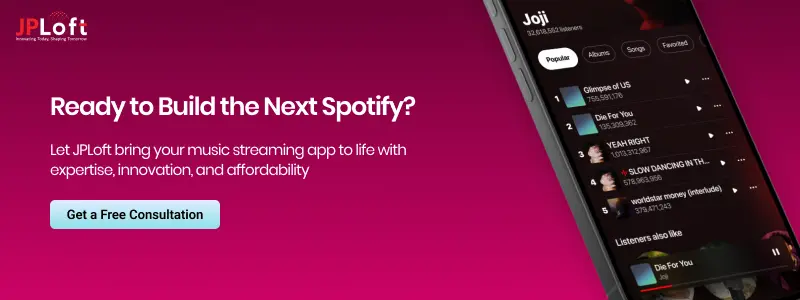
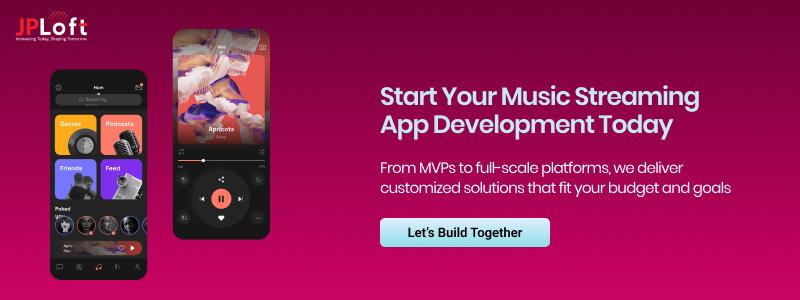
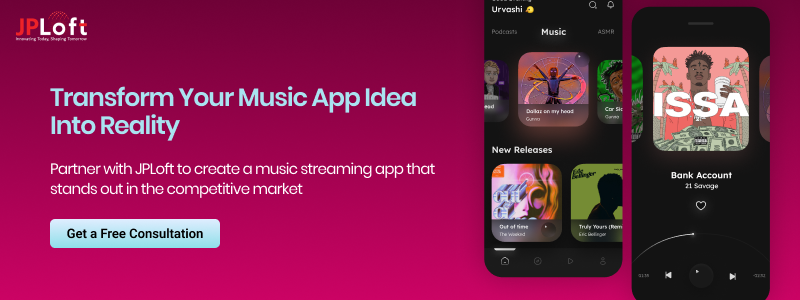

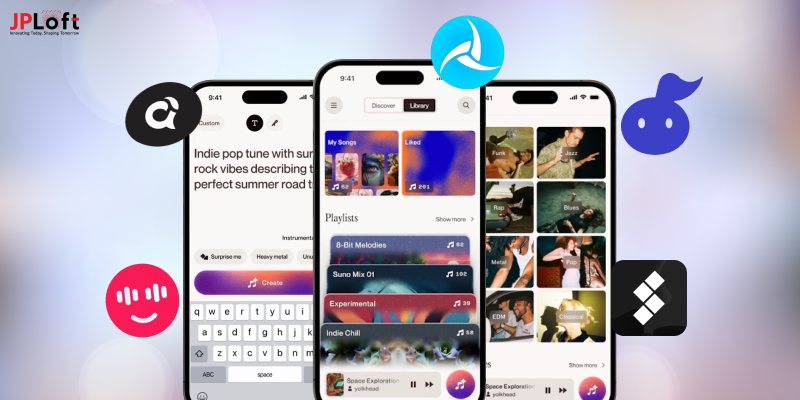
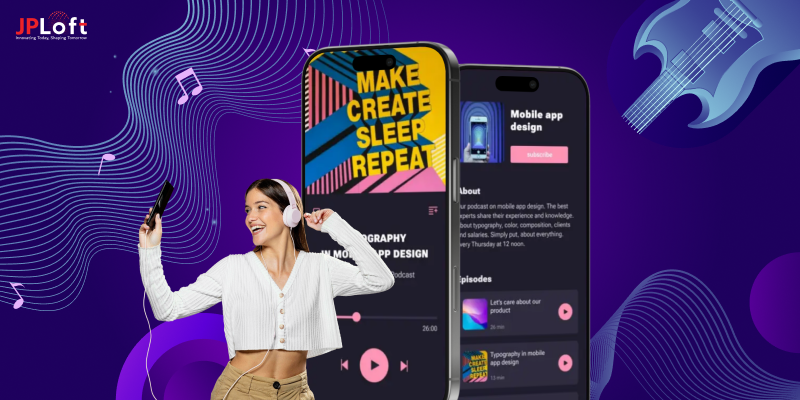
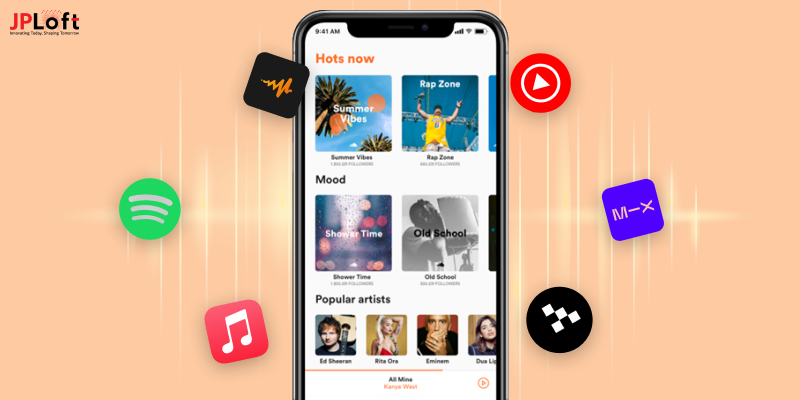



Share this blog